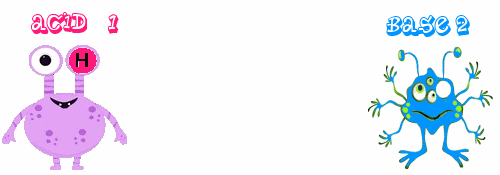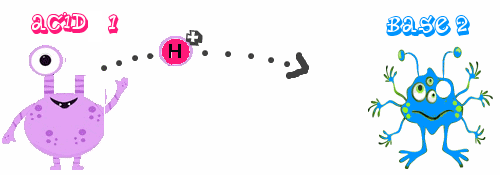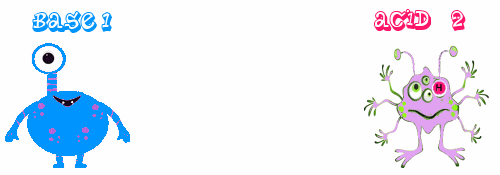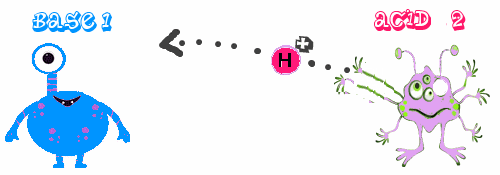






Johannes Nikolas Brønstedt (1879-1947)
An acid is species which gives protons A base is a species which takes protons
A proton goes from an acid1 to a base2.


A new acide2 is produced which holds the proton being able to give it back to the species which has been transformed to a new base1:


The switchover of a proton of a Broenstedt acid to a Broenstedt base is called protolysis
(In the following examples the acidic or basic "natures" are shown by the red or blue colour which is taken by bromothymol in acidic or basic medium)
Fluorhydric acid reacts with water:
$HF$ + $H_2O$ $\leftrightarrows$ $F^-$ + $H_3O^+$
acid 1 + base 2 $\leftrightarrows$ base 1 + acid 2
We notice that - water ( here a Brønstedt base!) receives a proton from fluorhydric acid and is transformed to the corresponding acid: the hydronium ion $H_3O^+$. - the hydrogen ion $H^+$ (= the transmitted proton $p^+$ !) is not free !
Introduced into water, ammonium chloride has an acidic nature due to the ammonium ion which reacts with water:
$NH_4^+$ + $H_2O$ $\leftrightarrows$ $NH_3$ + $H_3O^+$
acid 1 + base 2 $\leftrightarrows$ base 1 + acid 2
We notice that - the ammonium ion( a Brønstedt acid!) is not a substance ( a neutral species ). - the hydronium ion $H_3O^+$ which is present in all acidic solutions determines the acidic nature and not $H^+$ which is merely transmitted!
Introduced into water, sodium dihydrogenphosphate has an acidic nature due to due to the dihydrogenphosphate ion which reacts with water:
$H_2PO_4^-$ + $H_2O$ $\leftrightarrows$ $HPO_4^{2-}$ + $H_3O^+$
acid 1 + base 2 $\leftrightarrows$ base 1 + acid 2
We notice that a Brønstedt acid may be a molecule, a cation or even an anion ( as in this case ).
Introduced into water, ammonia has a basic nature. It reacts with water:
$NH_3$ + $H_2O$ $\leftrightarrows$ $NH_4^+$ + $OH^-$
base 1 + acid 2 $\leftrightarrows$ acid 1 + base 2
We notice that - water (here a Brønstedt acid !) gives a proton to ammonia and is transformed to the correspondingbase: the hydroxide ion $OH^-$. - water may be a Brønstedt acid or base depending on which it reacts with!
Introduced into water, sodium oxide has a basic nature due to the oxide ion which reacts with water:
$O^{2-}$ + $H_2O$ $\rightarrow$ $OH^-$ + $OH^-$
base 1 + acid 2 $\rightarrow$ acid 1 + base 2
We notice that - even the hydroxide ion may be (theorically) considered as a the Brønstedt "acid" corresponding to the oxide ion ( Brønstedt base)! - in this case the opposite reaction is practically nonexistent. That's why we write the simple dash ($\rightarrow$). That will be discussed later.

Ammonia (g) reacts with hydrogen chloride (g) :
$NH_{3\;(g)}$ + $HCl_{\;(g)}$ $\rightarrow$ $NH_4^+$ $Cl^-$$_{\;(s)}$
base 1 + acid 2 $\rightarrow$ acid 1 + base 2
We notice that - the proton exchange is made without the water as a solvent! - the white smoke is ammonium chloride (solid!)
Reaction of acid and base: Acid 1 + base 2 $\leftrightarrows$ base 1 + acid 2 A special case: Acidic hydrolysis: Acid +$H_2O$ $\leftrightarrows$ base + $H_3O^+$ A special case: Basic hydrolysis Base +$H_2O$ $\leftrightarrows$ acid + $OH^-$
Acid and corresponding base make an acid - base couple for instance $(HF$,$F^-)$ $(H_2PO_4^-$,$HPO_4^{2-})$ $(NH_4^+$,$NH_3)$ $(OH^-$,$O^{2-})$...